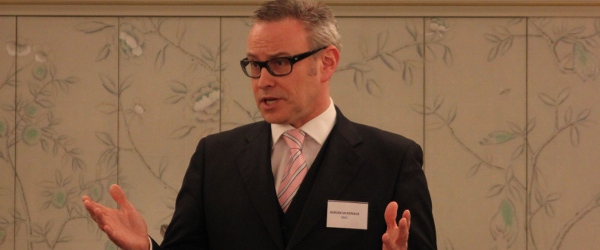
How has the IT storage sector been shaping up over the past year or so?
The mega trends are digital customer experience, the massive fragmentation of the IT industry, the massive fragmentation around choice, and the question that the schism between second platform and third platform apps is bringing to big businesses.
One of the mega trends around storage is ‘who cares about storage?’ I think even at our recent EMC event in London there was a recognition of that trend. Our VMAX3 is a world beating product but we didn’t even talk about that technology. We have the world’s best disk technology and, to some extent, who cares? It’s really about what you wrap that in, how you make it compliant, how you make it secure, how you make it business continuant, and how you bring that in the right way to achieve the business or citizen outcome.
Our job is to help people take a tonne of cost out of second platform apps – so today’s SAP, Oracle etc – to make those as agile as we can and to help people use some of that investment. Everyone talks about reducing the cost of IT, but that’s not actually what they mean. Their IT budgets are still going up. What they mean is they want to make as much of that money available for new applications and new development. They want to get to third platform as soon as they can.
They want to get to environment where they can use open platforms or build things that are made for web scale. Everything’s about web scale right now. They want to go to global markets. Not just the corner store. They have ideas and innovations they want to get to market as soon as they can and IT is the key enabler for getting that done.
With so many storage solutions being developed and offered by an ever-increasing number of vendors, to what extent do you think the discussion around all these new products just creates confusion for the end user?
I definitely see this. When I say that the IT sector is fragmented there are many ways of discussing that. It used to be you had the monolithic CIO who was running IT for a business and they were pretty much the lords of all they surveyed. And the choices were relatively few – you could either go A, B or C and couldn’t really get it wrong.
Obtain enough of the solutions available, you’ll kind of be going in the right direction and you’ll kind of map it out. Nowadays, the choice has proliferated. Do you go on-prem, off-prem, how much independence do you give to the business units? How quickly is the business being pulled?
The digital world means your company can do anything, so you’re not just limited to your own market and that means your competition isn’t limited to their market. It’s causing this great plethora of confusion and the net outcome of that is that companies, CFOs and CEOs in particular, aren’t making very big IT decisions.
They’re still outsourcing and they’re trying to take it in bite size chunks and they’re trying to do it with a TCO that’s 6-18 months and, if it’s done within a financial year, then it pays off within 12 months and it’s half logical then they’ll do that. They’re taking mini steps that take them in the right direction and, hopefully over time, form a platform going forward.
I’m certainly seeing that. But that said, there are some companies that have a complete story, a complete vision, and they actually have the technologies and the knowledge of how they’ll get from where they are to where they need to be, and there are some companies that don’t.
With more people at boardroom level, such as CFO’s and CEOs, getting involved in IT decisions do you think this helps or hinders the development of an company’s IT structure?
It depends on the company and depends on the individuals. I wouldn’t say there are hard and fast rules there. It’s possible for a company to come from nothing to something quite large relatively quickly in a way they couldn’t have done before. It’s also possible for a company to go from something quite large to something quite insignificant relatively quickly, so the pace of change is phenomenal.
It used to be that IT was the tail end of the donkey – the thing at the end of business that did some background processes and you didn’t really bother about it. Increasingly, IT actually is the business so everyone needs to be involved. There needs to be a conscious policy for what they’re trying to achieve.
One of our fears are our recent EMC event is that we may have said to much stuff – too much technical stuff – when, in actual fact I’ve not had a question that would have involved any of the answers we gave in those presentations for years. On one level, nobody is remotely interested in the technicalities. What they’re interested in are the outcomes.
We specialise in how you put these things together, sometimes with partners, to get a given business outcome. And, honestly, we’re really very good at it. People love our brand. The technology is world beating.
I think one of the big changes for EMC has been, as the market has fragmented, our answers multiply. The questions companies ask us are roughly the same but everyone’s preference about how they approach those questions have nuances, so you have to deal with all the nuances.
There are plenty of companies still using tape storage and some vendors, such as Sony, have been developing new tape storage solutions this year. How important do you think tape, and even disk storage, is considering continued flash array developments?
The announcements we made recently regarding upgrades to our flash array solutions were the death knell of disk storage. Tape storage officially died five to eight years ago but there’s a very long tail.
There are many customers that don’t have any tape and don’t backup to tape anymore. They backup to disk and they have technologies that help them overcome any issues of not having tape but then there are some customers that still have automated tape for a variety of reasons.
Disk sales, two years ago, were at their peak. Then these sales figures dropped, a year ago they dropped again and I would suggest they’ll drop further this year. We’ll still sell a lot of disks and they’ll be bigger in capacity than before but, economically it doesn’t make sense.
The tape will certainly make it to 2020, disk may make it to 2025-2030 but we’re moving very quickly to flash. Most of my customers either want flash for their top tier of performance or they want it fully integrated with instantaneous response, and some customers now say they want all flash – no flash, no disk – depending on their needs.
When you speak with customers and potential customers, what do they say are there main concerns when it comes to building their storage infrastructure?
Security, depending on the country and environment, is definitely a big one. But if security, compliance and business continuity were a given – which they are not – then it’s ultimately a cost and agility game. It’s about speed. How quickly can you develop your new apps? Can you get your new products to market quicker than anyone else? Can I do it with less money? For example, ultimately, what’s a bank? It’s a brand and a factory. What’s a telecoms firm? A brand and a network. The way IT works today, if you can speed up the factory and you can get the digital customer experience right then you win on both ends. It’s critical – life and death critical.
In the UK, look at Marks & Spencer and Next. There are lots of companies that ‘got it’ and ones that didn’t. Who would have thou8ght that Next would become more valuable than Mars & Spencer? But Marks & Spencer thought you would still come into the shop for your Christmas sweater, then buiy a bunch of other stuff and missed the Internet, missed samne day delivery, missed pick up goods in-store. Next went with these things all driven by the IT platform.
What advice would you give to companies as far as their approach to storage is concerned?
The two watch words are agility and security. If you’re a business and not agile enough you won’t be a business for much longer.
Look at Morrisions, getting completely mullered by Lidl and Aldi, not getting the digital customer experience that the likes of Waitrose and Sainsbury’s have got to work. You can’t be a retailer and not be an expert in IT. You can’t be a manufacturer and not be an expert in IT. You certainly can’t be a banker and not an expert in IT.
Risk management in banking used to be a bunch of intelligent guys with pens and paper, maybe even a dictaphone. These days risk management is about going into the systems and having real time understanding with alarms about what’s going on by the second. It’s all IT and you have to have an opinion. It’s why the CIO has become less relevant. It’s no longer the case that it’s just the CIO who knows about IT. The CEO has to be an expert on IT, so focus on agility.
I read a story the other day about RBS’s approach to payday lending. Companies like Wonga have come in with a different set of It tools and marketing, which RBS should probably have been using itself. Now, they’ve missed that opportunity.
You have to be nimble enough to not just survive, but thrive. If you’re not leading in many of these new environments then you’re losing.






